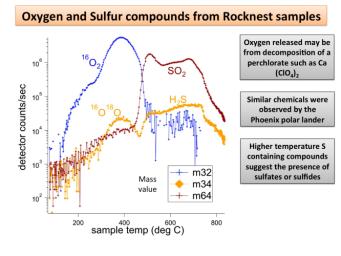
|
Signs of Perchlorates and Sulfur Containing Compounds
- Click the image above for a larger view
- Full-Res JPEG (1600 x 1200) (189.8 kB)
- Full-Res TIFF (1600 x 1200) (5.8 MB)
Caption:
NASA's Mars rover Curiosity has detected sulfur, chlorine, and oxygen compounds in fine grains scooped by the rover at a wind drift site called "Rocknest." The grains were heated and analyzed using the rover's Sample Analysis at Mars, or SAM, instrument suite. Scientists indicate the oxygen and chlorine may come from perchlorate or similar compounds, which contain chlorine and oxygen. Perchlorates were also found by NASA's Phoenix Lander at a different location on Mars. The sulfur compounds suggest the presence of sulfides or sulfates in the grains.
Background Info:
JPL manages the Mars Science Laboratory/Curiosity for NASA's Science Mission Directorate in Washington. The rover was designed, developed and assembled at JPL, a division of the California Institute of Technology in Pasadena.
For more about NASA's Curiosity mission, visit: http://www.jpl.nasa.gov/msl , http://www.nasa.gov/mars , and http://mars.jpl.nasa.gov/msl .
Cataloging Keywords:
| Name | Value | Additional Values |
|---|---|---|
| Target | Mars | |
| System | ||
| Target Type | Planet | |
| Mission | Mars Science Laboratory (MSL) | Phoenix |
| Instrument Host | Curiosity Rover | Phoenix Lander |
| Host Type | Rover | Lander |
| Instrument | Sample Analysis at Mars (SAM) | |
| Detector | ||
| Extra Keywords | Color | |
| Acquisition Date | ||
| Release Date | 2012-12-03 | |
| Date in Caption | ||
| Image Credit | NASA/JPL-Caltech/GSFC | |
| Source | photojournal.jpl.nasa.gov/catalog/PIA16575 | |
| Identifier | PIA16575 | |
